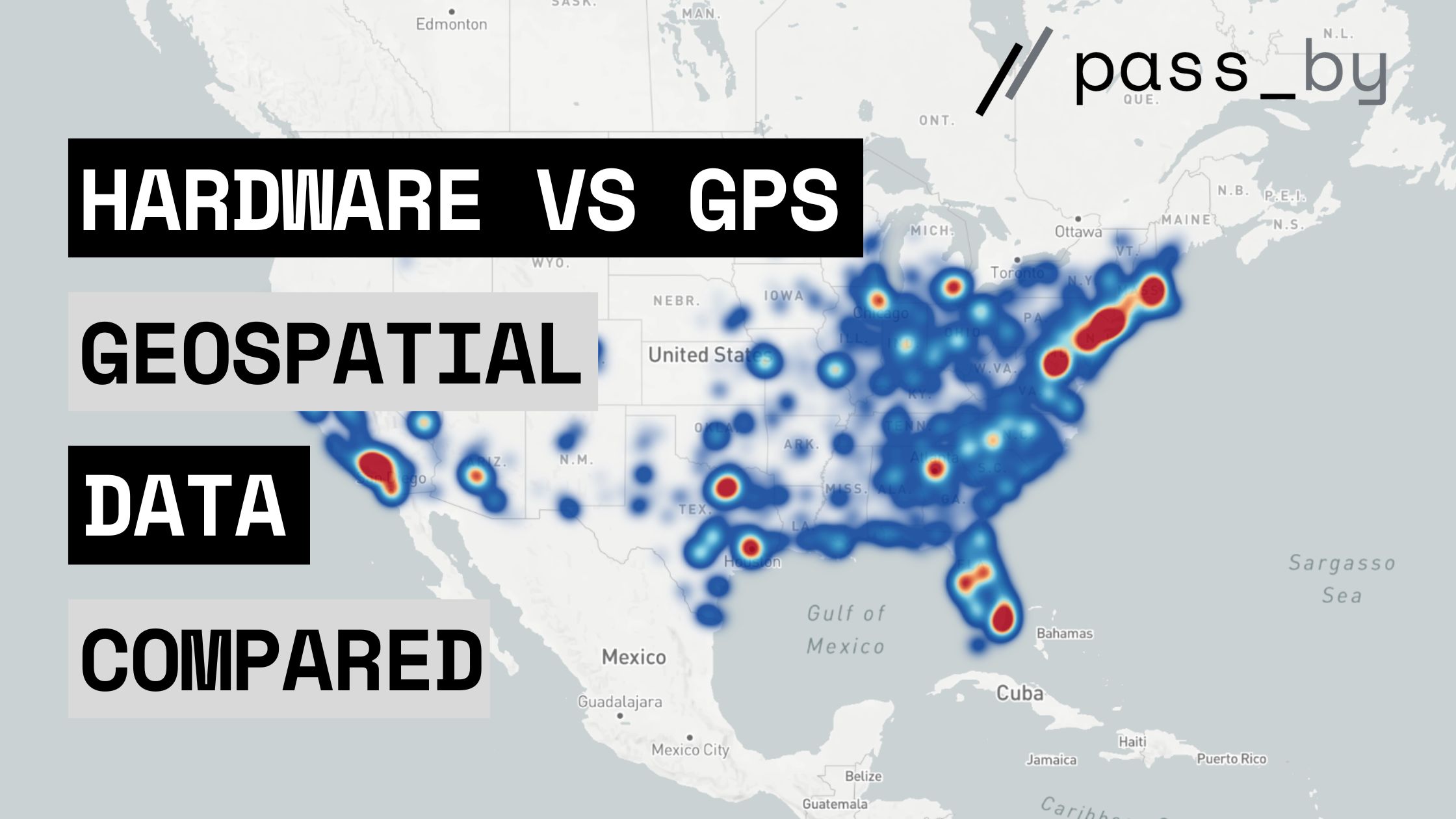Whether you’re a retailer, data analyst, or a business decision-maker, understanding the strengths and weaknesses of various data sources is crucial. We’ll explain the differences between GPS and hardware-based geospatial data.
“Over-reliance on GPS data from geospatial data providers has led to a lack of trust from decision-makers, who have accuracy and consumer privacy concerns. Looking to a wide range of anonymized, aggregated data sources is more important than ever.”
At pass_by, we offer the highest in market accuracy with 94% correlation to ground truth, over 15 data inputs, and a full 90 days of predictive feeds. Book a call now.
Jump to:
Where geospatial data comes from
Where geospatial data originates from is crucial to its level of accuracy, precision and reliability. Geospatial data comes from two primary sources – GPS or hardware.
GPS data
Global Positioning Systems (GPS) are the most well-known method of collecting geospatial data. Using satellites, these systems receive signals and calculate how long it takes from the tracked object on earth to satellites in outer space to deliver information about a location of interest.
For example, a mobile device with GPS enabled can tell a retail company when a customer has visited and where they go in store.
Hardware data
Hardware systems produce a vast amount of geospatial data. The hardware is installed in the location, maintained and used to track various datapoints. Hardware made for geospatial data includes infrared beams and pressure sensors.
For example, a store may have pressure sensors at its main entrance to track the number of visitors that enter and leave.
Differences between GPS and hardware data sources
In a nut shell, GPS data can offer broader aggregated insights but can be less accurate depending on signals. Hardware is highly accurate within its specific area but does require installation and lacks further insights.
| Geospatial data | Hardware data | |
| Collection method | Sourced from smartphone location services | Sensors detect movements (i.e. Beams interrupted or pressure applied) |
| Accuracy | Accuracy varies greatly | Accuracy is steady |
| Coverage agrea | Can track movement across broad areas as long as location access is enabled | Tracks movement within a specific location or zone where hardware is installed |
| Additional insights | May offer further insights depending on app usage | Limited data provided |
| Privacy | Relies on opt-in location sharing settings | Data is inhertently anonymous |
| Installation | No installation required | Requires physical installation and maintenance |
| Cost | Data providers charge fees, the cost of which varies | Upfront installation and purchase cost, in addition to ongoing maintenance costs |
Are hardware systems more accurate than GPS?
Yes. Data from hardware is more accurate than GPS data. The accuracy of GPS data can vary, leading to under counting and inaccurate data.
Hardware systems, however, directly detect movement. Infrared beams do this by monitoring when a beam is interrupted by someone passing through and pressure sensors can detect the weight of someone or something on it. Hardware results in high accuracy for where it is installed, but it can’t offer any further insights.
What factors influence the accuracy and precision of GPS data?
The accuracy and precision of GPS data depends on phone location services, which can be affected by factors such as being indoors, poor signals, or users opting out of location tracking.
Assisted GPS (A-GPS) technology also plays a crucial role in enhancing accuracy, particularly in challenging environments like urban areas with tall buildings or locations where satellite signals are weak. A-GPS uses data from local cell towers and Wi-Fi networks to augment satellite signals, thereby providing more reliable and quicker location fixes.
What factors affect GPS accuracy?
Many factors can contribute to the accuracy of GPS data. Among these are:
- Satellite geometry
- Signal blockages from the local area
- Condition of the GPS reciever
- Location of nearby tree, buildings, bridges, etc
In contrast, hardware systems like ground-based sensors or triangulation methods can offer superior accuracy, often down to the centimeter level. These systems are less susceptible to blockages and do not rely on satellite signals.
Should I use GPS data or data from hardware?
Whether you should use data GPS or hardware depends what you need the data to do.
Need information on a specific location? Hardware is likely the better choice.
Does your location have good signal and do you also need further insights? GPS data may be the better option.
If your goal is to increase foot traffic, or to truly understand your visitors and location, using a mix of both data sources delivers the best of both worlds.
The biggest mistake retailers and real estate professionals can make is to rely solely on the back of GPS data. Due to its accuracy and availability issues, particularly as laws tighten on privacy, then using hardware becomes all the more important.
What are the drawbacks of GPS data?
While GPS data is incredibly useful and widely available, it comes with its own set of limitations that you need to be aware of for geospatial usage. These drawbacks include:
Local factors
If you or your competitors are in a low or poor signal area, then the data will not be accurate.
For instance, tall buildings and urban structures can create a phenomenon known as “urban canyoning,” where GPS signals bounce off surfaces, causing inaccurate readings. Similarly, natural obstacles like dense tree cover or mountainous terrain can obstruct or weaken GPS signals, leading to errors in pinpointing locations.
Quality of GPS devices
More advanced and costly equipment, such as survey-grade GPS devices, offer superior accuracy. They often integrate multiple satellite constellations and additional technologies like A-GPS for improved performance.
Number of satellites
The number of satellites a GPS receiver can communicate with also plays a crucial role. A minimum of four satellites is necessary to calculate a 3D position accurately, but more satellites typically enhance the accuracy and reliability of the data.
The down side is that poor satellite geometry, where the satellites are clustered closely together in one section of the sky, can have a negative impact.
Privacy concerns of GPS data
When considering geospatial data, privacy is a significant factor that can’t be overlooked. GPS data inherently involves tracking movements, which can lead to concerns about who has access to that information and how it might be used. For individuals and businesses alike, the risk of data breaches or misuse of location data is a real worry.
Further complicating the issue is the fact that many GPS devices and applications share data with third parties. These third parties may not always have stringent data protection policies, increasing the risk of a data breach or misuse.
Governments have cracked down on data privacy in recent years. For example, the General Data Protection Regulation (GDPR) and the California Consumer Privacy Act (CCPA).
A data provider with a stringent private policy and data procedure can be a great help in alleviating these concerns, as data is provided anonymized and aggregated within a platform.
Why use hardware for geospatial data?
Hardware systems offer unparalleled accuracy compared to GPS. These systems are specifically designed for capturing geospatial data with exactness, making them invaluable for collecting data requiring high levels of accuracy and reliability.
While GPS data has itsbenefits, particularly for broader applications and ease of use, hardware systems are superior when it comes to accuracy, precision, and reliability in specific or signal-challenged environments. For any project where exact geospatial data is critical, investing in quality hardware solutions is often the best choice.
What type should I use for competitive intelligence?
GPS and hardware data have their own unique benefits and drawbacks when considering which one to use for your own location. When it comes to researching your competitors, the situation differs.
When researching your competitors, data is crucial. The more accurate the data, the informed you are and the better your next moves will be.
Complete competitive intelligence can’t be done with one type of data. This will give you limited information and limit your analysis. Instead, choose a data provider with tools for gathering competitive intelligence. The data provider should offer data from a variety of sources at a high accuracy rate.
How do I get GPS data and data from hardware?
There are a few things you can do to acquire GPS and hardware geospatial data for your location.
- Install hardware: Having your own hardware means you will be able to track the data points you need for your location. However, this does mean you’re left in the dark about further aggregated insights such as the age and income levels of your visitors. Additionally, hardware data in your location doesn’t give you any details about locations elsewhere.
- Work with a GPS data provider: A data provider can give you GPS data on your location, such as the number of visitors, dwell time, and demographic data. The provider can also provide information on other location of interest, such as your competitors. However, its accuracy may be limited.
- Work with a geospatial data provider: A data provider that uses both data from GPS and hardware can offer the widest range of information along with the best accuracy.
At pass_by, we offer the highest in market accuracy with 94% correlation to ground truth, over 15 data inputs, and a full 90 days of predictive feeds. Book a call now.






